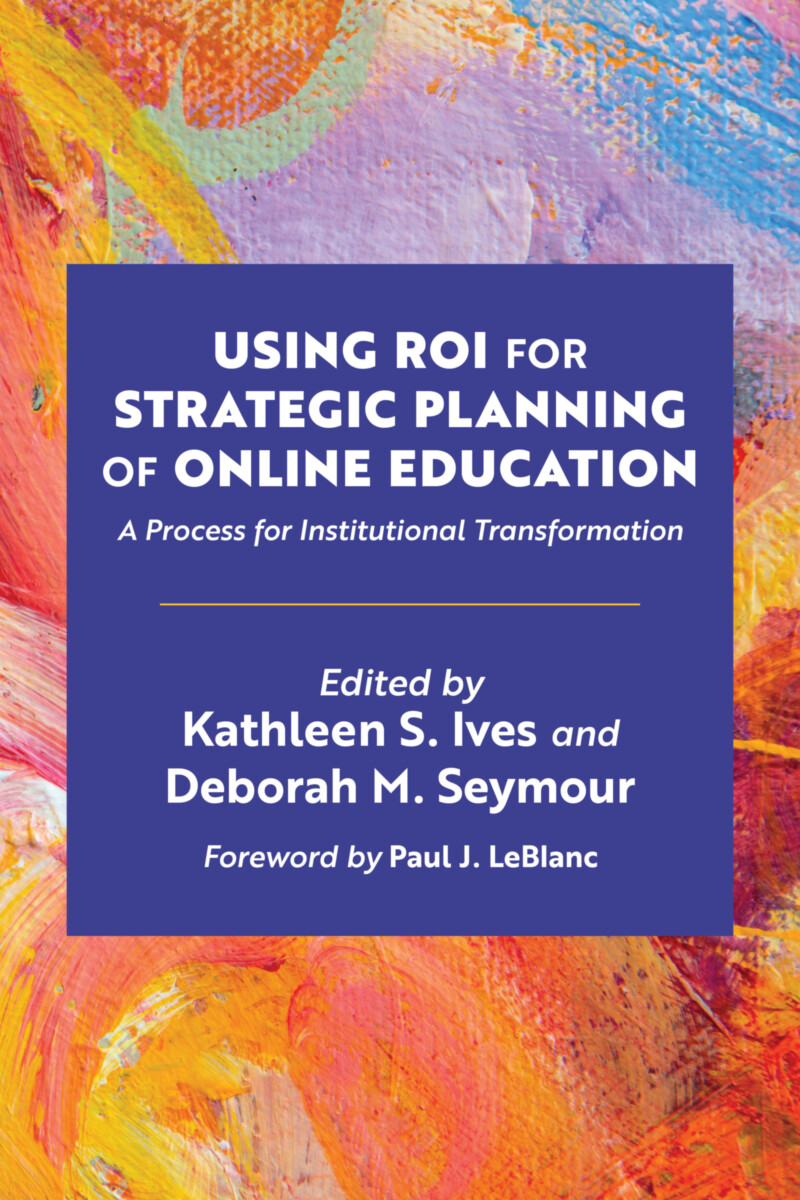I’ve known Deborah M. Seymour and Kathleen Ives for a number of years. In addition to other positions, Deborah was chief academic innovation officer at the American Council on Education (ACE) and Kathleen was CEO of the Online Learning Consortium (OLC). When I was president of APUS, we engaged Deborah for a consulting assignment related to an online innovation that we wanted to implement. The two of them are eminently qualified to edit a book on the topic of examining the ROI of online education.
The book is organized in four parts: Strategy, Constituents and Players, Tactics, and Special Cases and Considerations. Fifteen articles are distributed across the four categories. The editors write in the book’s preface that “the book’s organization and structure were designed to broaden and deepen the field’s thinking about ROI.”
Appropriately, Part One is the Strategy section. The authors acknowledge that ROI has been all but overlooked in discussions about institutions’ strategic directions and their pathways to successful outcomes, particularly where it involves an analysis of online education. If your institution fits this description, you may just want to spend your time reading the three articles encompassing this section.
What Does ROI Mean in Online Higher Education? is the first article in the Strategy section, and it is authored by co-editor Ives. Ms. Ives begins her article by differentiating between the missions and ROI models between the for-profit and non-profit sectors in traditional higher education and online higher education. Her quoted source noting that “the success [of a for-profit higher education institution] depends on customer/student satisfaction with the product offered” and “online [for-profit higher education institutions] must be self-sustaining and responsive to economic factors to ensure their profitability” are reasonably accurate. Other quotes about “profit maximization” are not accurate (in my opinion).
Ms. Ives uses these points to set the stage that during the pandemic, for-profit online enrollments increased at the graduate level and had a lower decrease at the undergraduate level than higher education overall. She writes that public and private non-profit higher education institutions heavily rely on government appropriations and private donations, are more diverse in their online operating model than for-profit institutions, and have been resistant to classifying education as a product and the user as a customer. She adds that the current higher education institution financial picture cannot be solved by the unsustainable rise in tuition fees at rates greater than family income. Reforming the ROI model is a necessity.
The remainder of Ms. Ives article excellently introduces the concept of ROI analysis in higher education, the postsecondary ROI landscape, the significance of ROI in online higher education, proposes an ROI framework for digital learning, and recommends how to integrate ROI analysis into the mainstream of online operations.
ROI and Institutional Planning is the title of the next article written by Todd Hitchcock and Justin McMorrow. It’s sequenced well. If an institution’s leadership team is comfortable with the ROI concept and is ready to explore how to apply it to online education, this article can serve as the roadmap. To set the stage, the authors write that they always ask higher education leaders one question: “What are your goals for any new online education initiatives? Are they to extend your brand or generate revenue?… and you cannot say both.”
Once question one is answered, Hitchcock and McMorrow write that there are five key challenges colleges must solve to develop a structure for online delivery that will result in a solid return on investment. These challenges are:
- How do we identify the best programs to launch online?
- What do curriculum and instruction look like in an online program with an effective ROI?
- How do we determine if an online program will be financially viable?
- What needs to be done on a day-to-day basis to ensure a program is on track to deliver a strong ROI?
- What do we need to do to ensure the mid- to long-term viability of an online program?
The rest of the chapter focuses on presenting ways in which these challenges can be analyzed and solved. It’s brilliant, and it’s what the major online higher education institutions have been doing for years.
Is ROI the Right Way to Judge Online Higher Education? is the title of the third and final chapter in the Strategy section. Laurie Hillstock, Kathleen Ives, and Deborah Seymour conducted a virtual roundtable of five college presidents representing five different types of higher education institutions. Given the breadth of institutions represented, it’s likely that one of the presidents’ answers are representative of the situation at your institution.
For purposes of brevity, I am opting to list the titles of the remaining chapters with a note or two beside each. Some of them may be important to your institution and others may not be important.
Part Two: Constituents and Players
ROI and Shared Governance – the Faculty Role – Rod Hewlett addresses most of the sticky issues that must be navigated when you add/build online programs. Great instructors inspire online students just as much as they inspire on-campus students.
ROI and the Institutional Experience – Cindy Rowland writes about the accessibility issues that must be addressed for online students with disabilities.
ROI from the Student Perspective – Laurie Hillstock provides multiple student perspectives on ROI as submitted through 118 alumni surveys and several follow up interviews.
Part Three: Tactics
Planning and Control Models – Victoria Brown writes about ensuring a significant institutional ROI through considering, modeling, and analyzing appropriate baseline costs and earnings before making operational decisions.
Calculating ROI in Online Education – David Schejbal discusses the component parts of ROI, direct and indirect costs, opportunity costs, revenues, and the importance of the Social ROI from online programs as well as the financial ROI.
Financial Aid and the Impact of Net Price Calculators (NPCs) on ROI – Carlo Salerno writes about the challenges of using NPCs for online programs and concludes that more research is needed on how consumers use the tools, the tools need to be improved based on that research, and institutions need to be held more accountable for the NPC information.
Nonbudgetary Return on Investment – Kathy Fernandes discusses how to use the implementation of online programs as a catalyst for organizational changes.
Part Four: Special Cases and Considerations
ROI and Social Equity – Pamela Wimbush discusses Social ROI from the viewpoint of social, economic, and environmental outcomes. She includes OER, faculty diversity, student diversity, diversity as it improves the quality of online learning, community colleges, HBCU’s, Hispanic-Serving Institutions, and Asian American and Native American/Pacific Islander-Serving Institutions.
ROI and Accreditation of Online Programs – Leah Matthews discusses institutional accreditation and how institutional accrediting agencies look at distance education.
ROI and Online Competency-Based Education Programs – Lisa McIntyre-Hite, Carlos Rivers, and Charla Long provide an excellent overview and discussion about competency-based education programs in general and the cost efficiencies of offering them online to the institution and to the student.
ROI in the Wake of a Natural Disaster or Pandemic – Gordon Freedman writes about the richness of data about online education that occurred during the pandemic and how that may influence future online offerings as well as its costs.
ROI and Innovative Approaches to Online Education – Deborah Seymour writes about the growth of various online learning options and how they’re fundamentally changing higher education.
If there was something close to a cookbook for how to analyze and plan for the implementation of online education programs, Using ROI for Strategic Planning of Online Education would be it. Some chapters will have more relevancy than others, but the articles and the resources cited should be very helpful to senior leaders attempting to expand their online program offerings. I highly recommend it.











